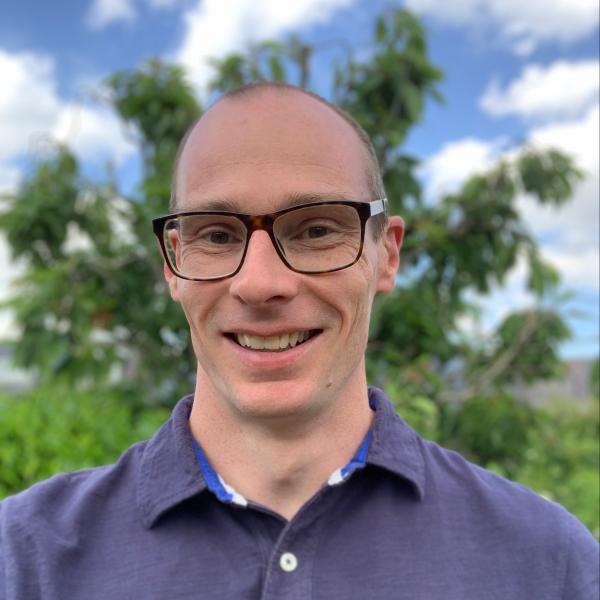Dr J. Grant Hill
School of Mathematical and Physical Sciences
Senior Lecturer in Theoretical Chemistry
Chemistry Programme Lead
Digital Experience Lead


+44 114 222 9392
Full contact details
School of Mathematical and Physical Sciences
Dainton Building
13 Brook Hill
Sheffield
S3 7HF
- Profile
-
Dr J. Grant Hill is a Senior Lecturer in theoretical chemistry, with primary research interests in the use of machine learning and other computational techniques to discover and analyse new molecules and materials. This is divided into two major strands, the development and application of new techniques in computational chemistry, and the development of self-driving labs for optimal formulations. The latter is conducted in collaboration both with research groups at the University of Sheffield and with multinational companies.
Grant has an MChem (2002) and PhD (2006) from the University of York. He spent 2005-2008 as a postdoctoral researcher in the group of Dr Jamie Platts at Cardiff University, and 2008-2010 at Washington State University in the group of Prof. Kirk Peterson. After a temporary lectureship and a Royal Society of Edinburgh Fellowship at the University of Glasgow, he joined the University of Sheffield in 2014. He was promoted to Senior Lecturer in 2022.
He is a member of the advisory board for the University of Sheffield's Centre for Machine Intelligence. He is also recognised for his teaching of physical chemistry, winning the University's Education Award in the category of Teaching Practice: Science in 2024. He also produced a series of video tutorials for "Atkins' Physical Chemistry", which can be accessed in the ebook version of the text, available from Oxford University Press.
- Qualifications
-
- MRSC
- FHEA
- Research interests
-
Grant's research interests revolve around the 'how' and 'why' of Chemistry, particularly in terms of discovery and insights into new molecules, product formulations and materials. Current areas of interest are outlined below:
Theory development
To be able to study interesting chemistry, new theories and tools need to be implemented and improved. We have recently developed a new method for accurate determination of interaction energies in complexes comprising large numbers of molecules, which scales linearly with the number of molecules. We also design, develop and optimise Gaussian basis sets for molecular systems, allowing high-accuracy calculations to be carried out on heavy elements.Machine learning & data science
We are investigating ways to improve current quantum chemistry approaches using the latest techniques from computer science and statistics. Machine learning and artificial intelligence techniques are also used by my group in the design of novel molecules, reaction schemes and materials. We also apply data science techniques to uncover trends and find physical insights in large chemical datasets (including a collaboration with the Cambridge Crystallographic Data Centre).Self-driving labs
Working with other research groups and non-academic partners, we are using theoretical chemistry, AI and computer control to help develop self-driving labs. We take a "closed-loop" approach where automated experimental results are used to re-train models that predict which experiment to perform next.
- Publications
-
Journal articles
- . Journal of Chemical Physics, 160(11).
- . The Journal of Chemical Physics, 159(4).
- . Journal of Computational Chemistry, 44(11), 1119-1128.
- . The Journal of Physical Chemistry A, 126(34), 5853-5863.
- . Journal of Physical Chemistry A, 126(16), 2511-2521.
- . Journal of Chemical Physics, 155(17).
- . The Journal of Open Source Software, 6(60).
- . Journal of Chemical Theory and Computation, 16(12), 7817-7824.
- . Physical Chemistry Chemical Physics, 22(28), 16421-16430.
- . Biophysical Journal, 118(3), 615a-615a.
- . Journal of Chemical Theory and Computation, 15(10), 5352-5369.
- . Inorganic Chemistry, 58(7), 4583-4591.
- . International Journal of Quantum Chemistry, 119(10).
- . Inorganics, 7(2).
- . Annual Reports in Computational Chemistry, 14(2018), 47-74.
- . Physical Chemistry Chemical Physics, 20(27), 18361-18373.
- . Molecular Physics, 116(11), 1460-1470.
- . The Journal of Physical Chemistry Part A, 122(1), 316-327.
- . The journal of physical chemistry. B, 122(13), 3339-3353.
- . Journal of Chemical Physics, 147.
- . Physical Chemistry Chemical Physics, 46(19), 31039-31053.
- . Crystals, 7(9).
- . Journal of Chemical Physics, 147(7).
- . Journal of Chemical Theory and Computation, 13(4), 1691-1698.
- . ChemPhysChem, 18(7), 828-838.
- . The Journal of Physical Chemistry A, 120(42), 8461-8468.
- . Physical Chemistry Chemical Physics, 18, 11091-11103.
- . Journal of Physical Chemistry A, 120(15), 2443-2458.
- . Journal of Chemical Theory and Computation, 11, 5269-5276.
- . Topics in Current Chemistry, 358, 43-78.
- . Physical Chemistry Chemical Physics, 17(2), 858-867.
- . Journal of Chemical Physics, 141.
- . Physical Chemistry Chemical Physics, 16(36), 19137-19140.
- . The Journal of Physical Chemistry A, 118, 2332-2332.
- . Crystal Growth & Design, 14, 1227-1239.
- . Physical Chemistry Chemical Physics, 16, 11754-11762.
- . JOURNAL OF CHEMICAL PHYSICS, 139(9).
- . JOURNAL OF COMPUTATIONAL CHEMISTRY, 34(25), 2168-2177.
- . JOURNAL OF CHEMICAL PHYSICS, 138(13).
- . CHEMISTRY-A EUROPEAN JOURNAL, 19(11), 3620-3628.
- . JOURNAL OF CHEMICAL THEORY AND COMPUTATION, 9(1), 330-337.
- . INTERNATIONAL JOURNAL OF QUANTUM CHEMISTRY, 113(1), 21-34.
- . JOURNAL OF PHYSICAL CHEMISTRY A, 116(16), 4159-4169.
- . JOURNAL OF CHEMICAL THEORY AND COMPUTATION, 8(2), 518-526.
- . MOLECULAR PHYSICS, 109(22), 2607-2623.
- . JOURNAL OF CHEMICAL PHYSICS, 135(14).
- . JOURNAL OF CHEMICAL PHYSICS, 135(4).
- . JOURNAL OF CHEMICAL PHYSICS, 135(4).
- . Advances in Applied Ceramics, 109(5), 253-259.
- . JOURNAL OF CHEMICAL PHYSICS, 133(18).
- . PHYSICAL CHEMISTRY CHEMICAL PHYSICS, 12(35), 10460-10468.
- , 723-742.
- . MOLECULAR PHYSICS, 108(11), 1497-1504.
- Current themes in cement research. Textile History, 41(1), 253-259.
- . JOURNAL OF CHEMICAL PHYSICS, 132(5).
- . JOURNAL OF CHEMICAL PHYSICS, 131(19).
- . CHEMICAL PHYSICS LETTERS, 479(4-6), 279-283.
- . JOURNAL OF MOLECULAR MODELING, 15(9), 1051-1060.
- . JOURNAL OF CHEMICAL THEORY AND COMPUTATION, 5(3), 500-505.
- . JOURNAL OF CHEMICAL PHYSICS, 129(13).
- . JOURNAL OF PHYSICAL CHEMISTRY A, 112(50), 12823-12828.
- . INORGANIC CHEMISTRY, 47(9), 3893-3902.
- . PHYSICAL CHEMISTRY CHEMICAL PHYSICS, 10(19), 2785-2791.
- . JOURNAL OF CHEMICAL PHYSICS, 128(4).
- . Advances in Cement Research, 19(1), 35-46.
- . JOURNAL OF CHEMICAL THEORY AND COMPUTATION, 3(1), 80-85.
- . PHYSICAL CHEMISTRY CHEMICAL PHYSICS, 8(35), 4072-4078.
- . JOURNAL OF PHYSICAL CHEMISTRY A, 110(25), 7913-7917.
- . Waste Management, 26(7), 758-768.
- . MOLECULAR PHYSICS, 104(5-7), 677-680.
- . Theoretical Chemistry Accounts, 115(4), 212-220.
- Advances in Concrete Technology Research at the Centre for Cement and Concrete, University of Sheffield. Concrete, 36, 47-49.
- . The Journal of Physical Chemistry A, 104(44), 9944-9952.
Book chapters
- Modern Basis Sets Across the Periodic Table In Yanez M & Boyd RJ (Ed.), Comprehensive Computational Chemistry (pp. 4-17). Elsevier Health Sciences
Conference proceedings
- . FARADAY DISCUSSIONS, Vol. 135 (pp 285-297)
Reports
- Teaching interests
-
Physical & theoretical chemistry
Active learning in the lecture environment
- Teaching activities
-
Undergraduate and postgraduate taught modules
- Diatomic molecules (Level 1). This course aims to equip students with the knowledge and skills necessary to interpret bonding in simple molecules. This involves discussing and applying models of chemical bonds, such as the Lewis model, valence bond theory and molecular orbital theory.
- Polyatomic molecules (Level 1). This course aims to expand models of chemical structure and bonding to molecules consisting of more than two atoms, revealing the strengths and weaknesses of each model.
- Quantum mechanics for chemists (Level 2). This component of the course is concerned with the origins and importance of quantum mechanics to chemists, followed by relatively simple models of the motion of molecules (translation, rotation and vibration - linking to spectroscopy).
- Molecular modelling (Level 3). This module introduces theoretical modelling as methods to explain experimentally observed properties of molecules and materials, and to predict properties of new molecules. Both quantum chemical and classical molecular modelling techniques are introduced. Hands-on workshops give students an opportunity to put these methods into practice to investigate chemical systems.
- Methods and Models in Theoretical Chemistry (Level 4). This course provides an overview of quantum mechanical modeling techniques as used in quantum chemistry calculations of molecular electronic structure. It also features hands-on workshops for students to explore how the methods work in practice.
Support Teaching:
- Tutorials: Level 1 General Chemistry.
- Chemistry projects: Level 3 Literature Review.
Laboratory Teaching:
- Level 4 Research Project
Links
